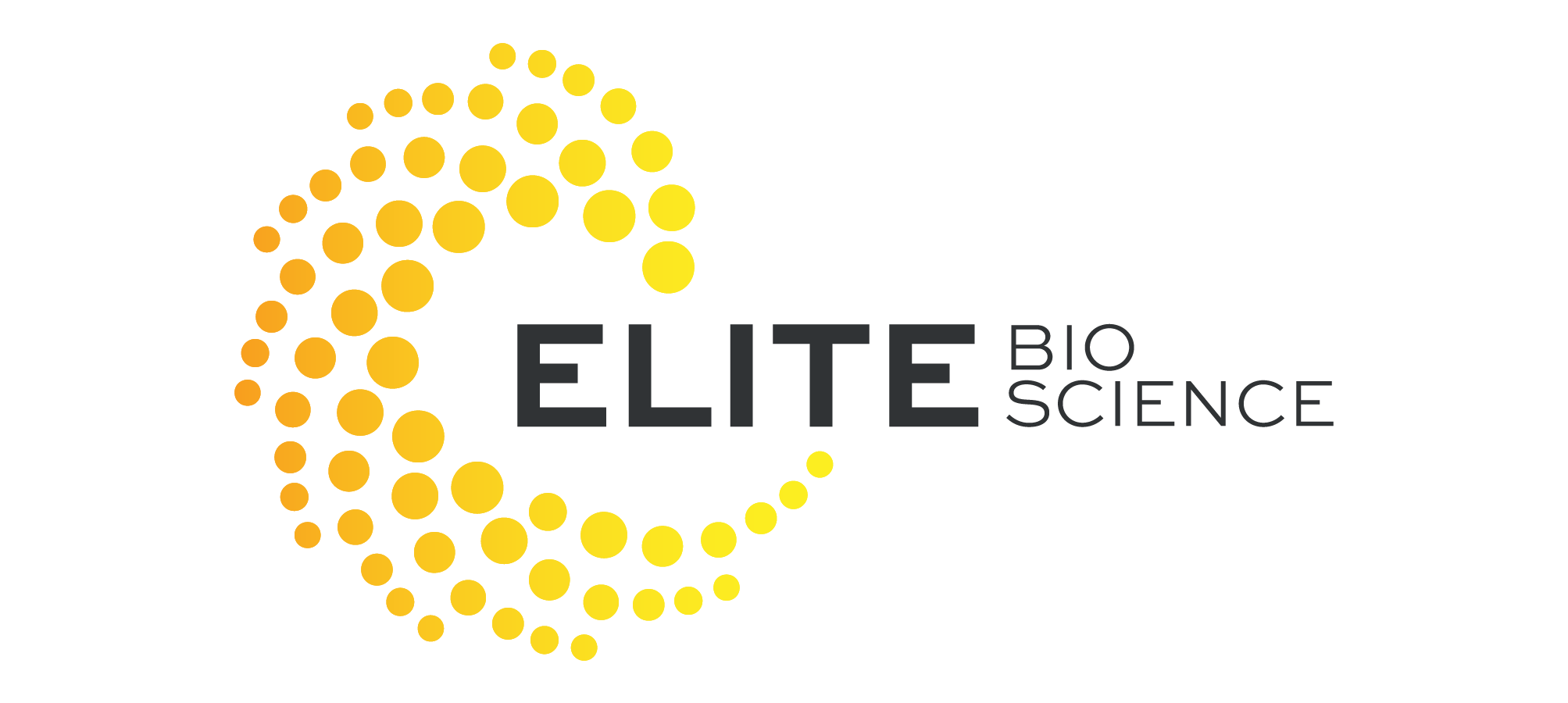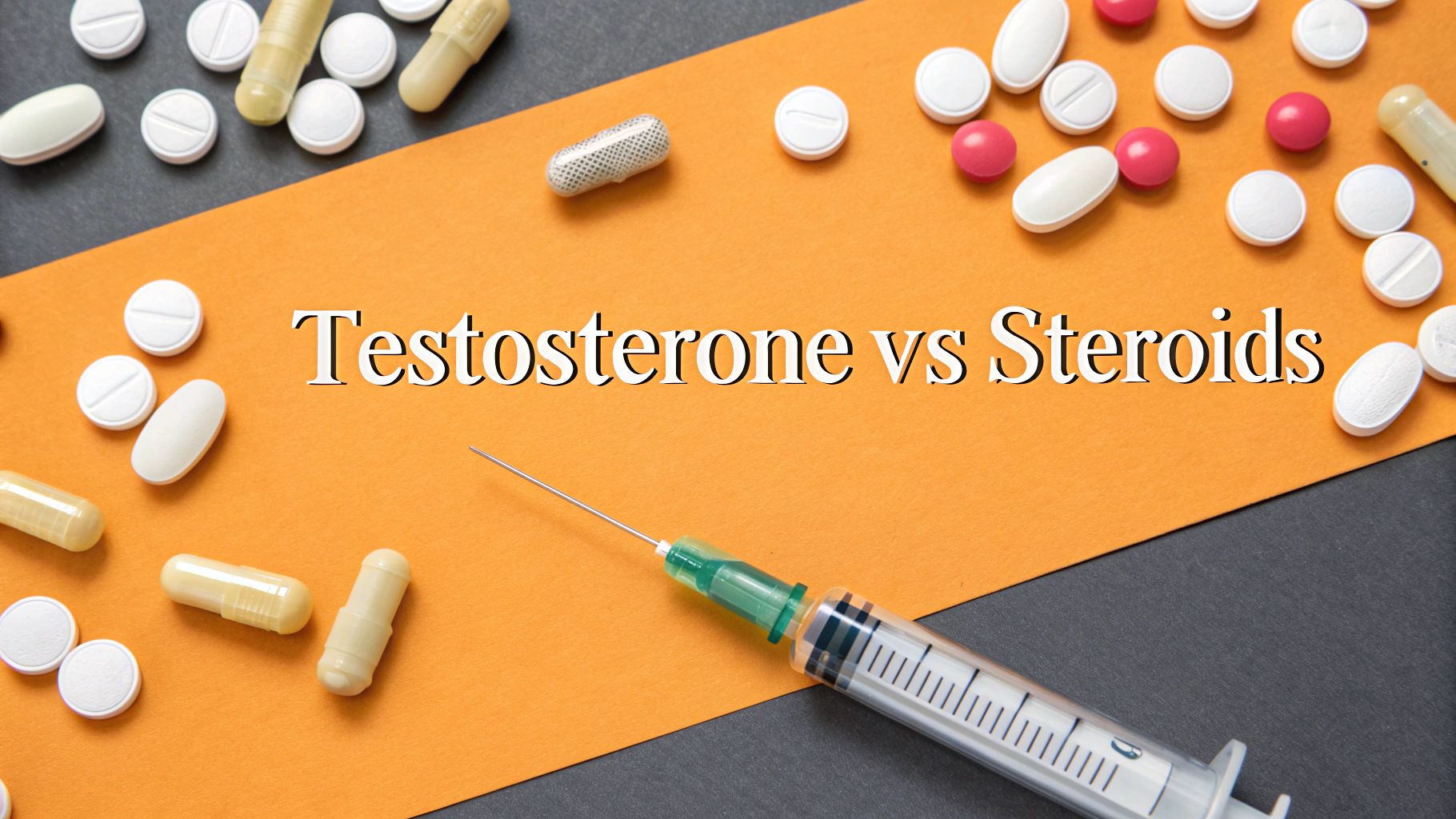TRT and Peptides A Guide to Hormone Optimization
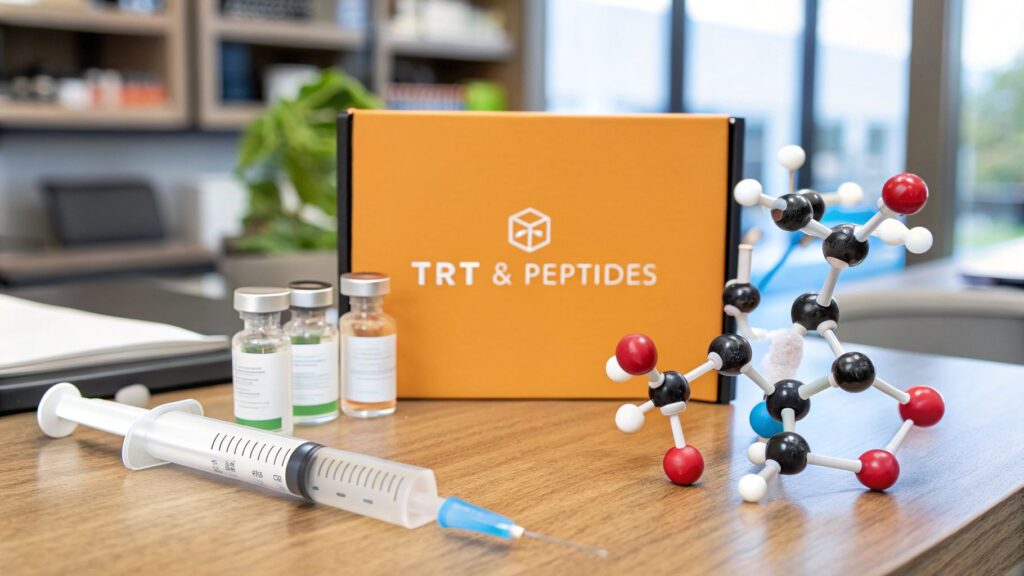
Combining TRT and peptides is a sophisticated way to approach hormone optimization, going far beyond just plugging a hole in a deficiency. Think of it like this: TRT restores your body’s foundational horsepower, while peptides offer the precision tuning needed to chase specific goals—like faster recovery, shedding stubborn fat, or just feeling more alive. It's a synergistic strategy that’s empowering people to take the driver's seat in managing their health for peak performance.
The New Frontier in Hormone Health
Welcome to the next evolution in personal wellness. For years, hormone therapy was pretty straightforward: find a deficiency and fix it. For men with symptoms of low testosterone, that almost always meant Testosterone Replacement Therapy (TRT) was the beginning and end of the conversation. And while TRT is incredibly effective, it only addresses one piece of a much larger puzzle.
Today, a far more complete picture of health optimization is coming into focus—one that pairs the foundational strength of TRT with the targeted, precise actions of peptide therapies. This guide is all about that powerful combination. We're moving beyond treating isolated problems to show you how these therapies work in concert to elevate your health, creating results that neither could ever achieve on its own.

Why Combine These Therapies?
To really grasp the synergy between TRT and peptides, let’s use an analogy. Imagine your body is a high-performance engine.
TRT is like making sure that engine has the right amount of high-quality oil and fuel. It restores core power and function, creating the fundamental environment needed for optimal operation. Without it, the engine sputters, lacking energy and efficiency. TRT fixes that foundational issue, bringing everything back to a state of readiness.
Peptides, on the other hand, are the precision-tuning components. They’re like specialized additives or ECU (Engine Control Unit) recalibrations that fine-tune specific systems. One peptide might improve fuel efficiency (metabolism), another might accelerate engine repair after a hard race (recovery), and yet another could enhance the cooling system (reducing inflammation).
By combining the two, you aren't just running the engine; you're optimizing it for peak performance in every possible way. TRT provides the stable, powerful base, and peptides direct that power toward achieving specific, targeted outcomes.
What This Guide Covers
This guide will unpack exactly why this combined approach is gaining so much momentum in the world of wellness and preventative medicine. We'll explore how it's giving individuals the tools to take control of their health, aiming for superior performance and vitality at any age. We will cover:
- The Role of TRT: Establishing the essential physiological foundation.
- The Power of Peptides: Understanding these targeted cellular messengers.
- Creating Synergy: How these two therapies amplify each other's effects.
- Safety and Protocols: Navigating treatment responsibly with medical guidance.
By the end of this guide, you'll have a clear understanding of how TRT and peptides can work together to help you achieve your health and wellness goals.
Understanding Testosterone Replacement Therapy
Before we can even talk about the cutting edge of peptides, we have to start with the bedrock of male hormonal health: Testosterone Replacement Therapy (TRT).
Think of testosterone as the master conductor of an orchestra inside your body. It does far more than just build muscle or fuel libido—it directs everything from your energy and mood to your mental focus and bone strength.
When your levels of this vital hormone start to drop, whether from age or other health issues, that orchestra falls completely out of tune. This is when you start feeling the effects: persistent fatigue, a nagging brain fog, stubborn weight gain, and a general sense that your vitality has vanished.
TRT is simply the process of bringing that conductor back to the podium. The goal isn't about creating superhuman strength; it's about restoring your testosterone to a healthy, youthful range and getting your body’s baseline operations back on track.
This is always the first—and most critical—step in any serious hormone optimization plan.
What Does TRT Actually Do?
At its heart, TRT tackles the root cause of symptoms tied to low testosterone, a condition known as hypogonadism. By reintroducing testosterone, a medically supervised protocol aims to reverse the downward spiral caused by the deficiency.
Patients who commit to a proper TRT plan often describe a dramatic turnaround in their quality of life. The benefits are tangible and widespread, and they often include:
- Improved Energy Levels: Say goodbye to that constant, draining feeling. Hello to sustained energy that carries you through the entire day.
- Enhanced Mental Clarity: The brain fog lifts, making way for better focus, sharper memory, and clearer thinking.
- Better Mood and Motivation: TRT can help level out irritability and bring back the drive and ambition you thought were gone.
- Increased Libido and Sexual Function: A healthy sex drive is one of the most common and welcome improvements reported by men on TRT.
This growing recognition of TRT's benefits is fueling major growth in the field. The global TRT market was recently valued at USD 1.9 billion and is expected to climb steadily over the next decade. This boom is driven by more men becoming aware of low testosterone and by newer, safer delivery methods that make therapy more convenient than ever.
TRT essentially repairs a cracked foundation before you start building the house. It creates the ideal physiological environment for other advanced therapies, like peptides, to actually work. It’s an absolutely essential first step for any long-term success.
Different Ways to Administer TRT
Just as there's no single dose that works for everyone, there are several ways to administer testosterone. The right method for you will depend on your lifestyle, personal preference, and what your doctor recommends. Each approach comes with its own set of pros and cons.
A critical part of any successful protocol is determining the right dosage, which is carefully calculated based on your individual bloodwork. For a deeper dive, you can learn more about how TRT dosage per week is calculated in our detailed guide.
Here's a quick look at the most common delivery methods and what you can expect from each.
Comparing TRT Administration Methods
| Method | Pros | Cons | Typical Frequency |
|---|---|---|---|
| Injections | Cost-effective, highly bioavailable, and allows for precise dose adjustments. | Requires self-injection, can cause temporary soreness at the injection site. | Weekly or bi-weekly |
| Topical Gels | Non-invasive and easy to apply at home. | Risk of transference to others, can cause skin irritation, requires daily application. | Daily |
| Pellets | Extremely convenient, provides steady hormone levels for months. | Requires a minor surgical procedure for insertion and removal. | Every 3-6 months |
No matter which method you and your doctor choose, one thing is non-negotiable: consistent medical supervision. Regular blood work is absolutely essential to monitor your hormone levels, manage any potential side effects, and ensure your protocol remains safe and effective for the long haul.
This structured, medically guided approach is what turns TRT from a simple treatment into a cornerstone of sustainable, long-term wellness.
Decoding Peptides: The Body's Signal Messengers
If Testosterone Replacement Therapy (TRT) is all about restoring your body's foundational power, then peptides are the high-tech communication network that directs that power with incredible precision. While testosterone provides a broad, systemic upgrade, peptides are far more specialized. They are the body’s own signal messengers, carrying specific instructions to targeted cells.
Imagine your body is a massive, complex construction site. TRT is like ensuring you have a full crew of strong, capable workers ready to go. Peptides are the foremen, each with a unique blueprint, telling a specific group of workers exactly what to do—whether that’s repairing a damaged structure, clearing out debris, or building a new framework.
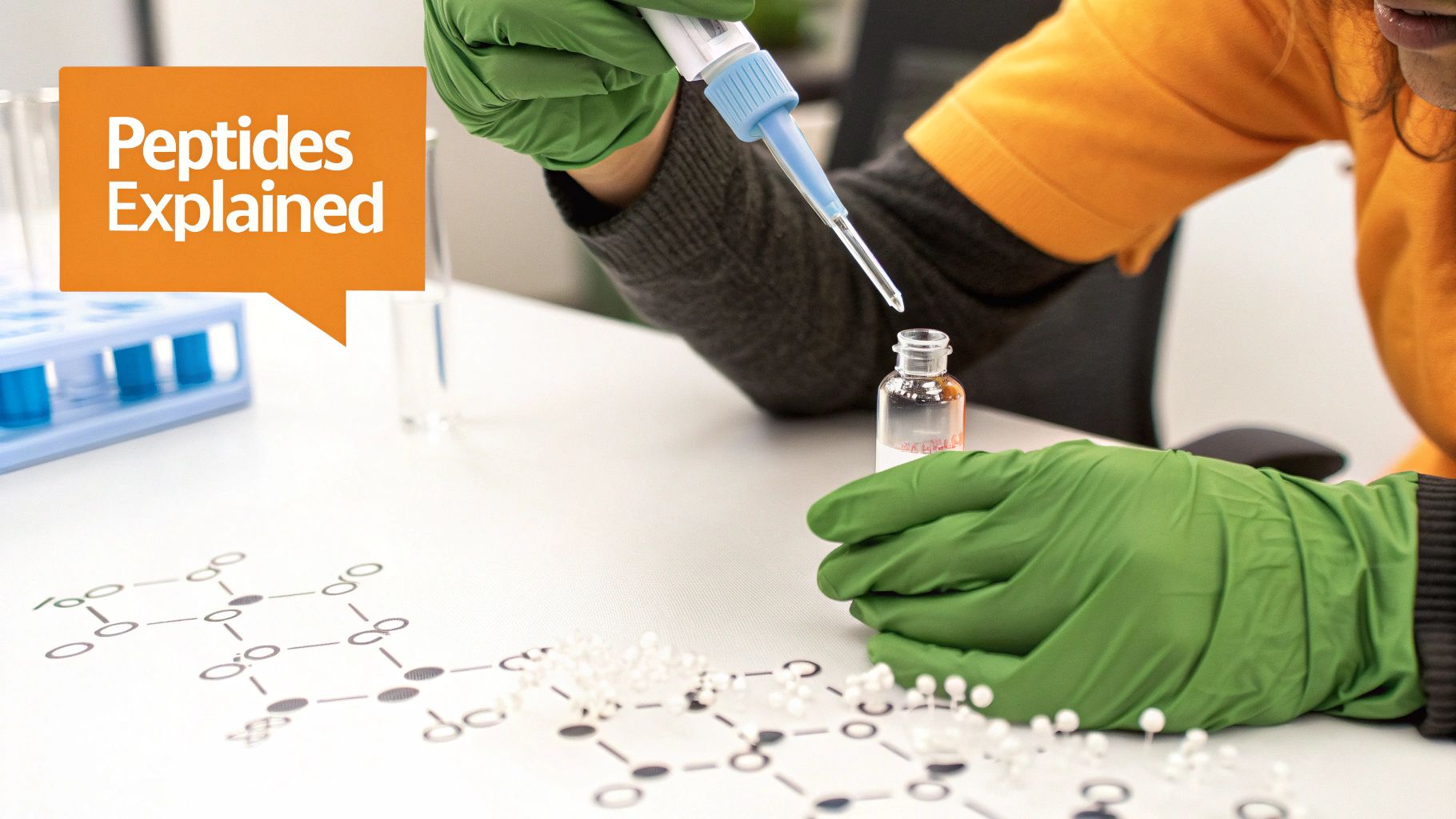
These tiny molecules, which are simply short chains of amino acids, act as highly specific keys designed to unlock particular cellular functions. This is why the synergy between TRT and peptides is so effective; TRT supplies the raw materials and workforce, while peptides provide the expert direction needed to achieve specific health goals.
How Do Peptides Work?
Unlike hormones that often have widespread effects, peptides are masters of specialization. They bind to specific receptors on the surface of cells, kicking off a cascade of actions inside. This targeted mechanism is what makes them so valuable for fine-tuning your health beyond what TRT alone can accomplish.
Think of it like a radio. TRT turns up the volume on the entire system, making everything louder and more robust. Peptides, however, are like tuning into a specific frequency to get a crystal-clear signal for a particular station—whether that station is broadcasting messages for muscle repair, fat metabolism, or skin rejuvenation.
This precision is why peptides have become a cornerstone of modern wellness protocols, allowing for a highly customized approach to health and performance.
Common Categories of Peptides
The world of peptide therapy is vast, with different compounds designed to achieve very different outcomes. By understanding their functions, you can begin to see how they can be strategically combined with TRT to amplify results.
Here are a few of the most well-regarded categories:
-
Growth Hormone Secretagogues (GHS): This is perhaps the most popular class of peptides used alongside TRT. Peptides like Ipamorelin and CJC-1295 work by stimulating your pituitary gland to release its own natural growth hormone. This can lead to improved recovery, better sleep quality, increased lean muscle mass, and reduced body fat—all without introducing synthetic hormones.
-
Healing and Repair Peptides: Peptides such as BPC-157 are celebrated for their regenerative properties. They have been shown to accelerate the healing of tissues like muscles, tendons, ligaments, and even the gut lining. For athletes or anyone dealing with nagging injuries, these peptides can be game-changers.
-
Metabolic Peptides: Some peptides are specifically designed to target metabolic processes. They can help regulate blood sugar, improve insulin sensitivity, and promote the breakdown of stored body fat, making them powerful tools for body composition goals.
This growing application in wellness is mirrored by significant market growth. The peptide therapeutics market in the United States was recently valued at approximately USD 103.66 billion and is projected to reach USD 336.12 billion within the next decade. This expansion is driven by their increasing use for anti-aging, muscle growth, and cognitive support, with telehealth services making access easier than ever. You can discover more about the peptide market trends on Grandview Research.
Peptides don't force your body to do something unnatural. Instead, they enhance and optimize the signaling pathways that your body already uses, making them a powerful yet subtle tool for health optimization.
Because of their targeted nature, you can gain a wide array of advantages when you add them to your wellness plan. You can learn more about the benefits of peptide therapy in our dedicated article on the topic.
This ability to direct and refine physiological processes is what makes peptide therapy such a perfect complement to the foundational strength provided by TRT. Together, they create a comprehensive strategy for achieving a higher level of health and vitality.
How TRT and Peptides Create Powerful Synergy
Combining Testosterone Replacement Therapy (TRT) and peptides isn't just about adding more tools to your wellness kit. It’s about creating a powerful physiological synergy where each therapy makes the other one better. The result? A level of optimization that neither TRT nor peptides could ever achieve on their own.
Here’s a good way to think about it: TRT is like renovating a house by fixing the foundation, upgrading the wiring, and making sure the plumbing is solid. It creates a stable, robust, and functional environment for everything else. Peptides are the specialized teams you bring in afterward—the interior designers, master electricians, and landscapers who turn that solid house into your perfectly customized home.
TRT establishes a strong anabolic baseline, restoring the energy, drive, and metabolic function your body needs for growth and repair. With that foundation firmly in place, peptides can then perform their highly targeted roles with maximum impact, directing your body’s enhanced resources toward very specific goals.
Amplifying Muscle Growth and Recovery
One of the most common reasons people explore TRT and peptides is to build lean muscle and speed up recovery. This is where the synergy becomes crystal clear.
TRT provides a constant anabolic signal, promoting muscle protein synthesis and dialing down the catabolic (muscle-wasting) effects of stress hormones like cortisol. This primes your muscle cells for growth.
Then, you introduce a peptide stack like CJC-1295 and Ipamorelin. These peptides work by nudging your own pituitary gland to release growth hormone (GH) in a natural, pulsatile rhythm. This surge in GH kicks muscle repair into high gear, reduces inflammation, and improves sleep quality—which is when the real recovery magic happens.
The result is a one-two punch: TRT builds the potential for growth, while the peptides unlock and accelerate the recovery processes needed to realize that potential. You're not just training harder; you're recovering smarter and far more efficiently.
Accelerating Fat Loss and Metabolism
For those focused on shedding stubborn body fat, the combination of TRT and peptides offers a multi-pronged attack. Low testosterone is often linked to increased visceral fat and poor insulin sensitivity. TRT helps correct this by improving your metabolic rate and making your body more efficient at using energy.
When you add specific peptides into the mix, you start hitting fat loss from different angles:
- Growth Hormone Secretagogues: Peptides that increase GH levels also promote lipolysis—the actual breakdown of stored fat for energy.
- Metabolic Peptides: Other peptides can directly improve insulin sensitivity, helping your body manage blood sugar more effectively and store less energy as fat in the first place.
This combination turns your body into a more efficient metabolic machine. TRT restores the baseline hormonal environment for fat burning, while peptides fine-tune the specific pathways that release and burn stored fat. While some peptides can influence natural hormone production, it's important to understand the distinctions. For those curious, you can explore our guide on peptides to increase testosterone to see how they differ from TRT's direct replacement model.
Targeting Goals with TRT and Peptide Combinations
The true power of this synergistic approach lies in its customizability. By pairing the foundational support of TRT with specific peptides, a protocol can be designed to target precise wellness goals. The table below shows just how these combinations work in practice.
Targeting Goals with TRT and Peptide Combinations
| Patient Goal | TRT Contribution | Complementary Peptide(s) | Synergistic Outcome |
|---|---|---|---|
| Lean Muscle Gain | Increases muscle protein synthesis and anabolic potential. | CJC-1295/Ipamorelin | Amplified growth hormone release leads to superior muscle repair, recovery, and lean mass accretion. |
| Injury Repair | Reduces systemic inflammation and supports tissue health. | BPC-157 / TB-500 | Targeted peptides accelerate the healing of tendons, ligaments, and muscle tissue for a faster return to activity. |
| Enhanced Vitality | Improves energy, mood, and cognitive function. | Semax / Selank | Nootropic peptides enhance focus and mental clarity while reducing anxiety, complementing TRT's mood-stabilizing effects. |
| Fat Loss | Boosts metabolic rate and improves insulin sensitivity. | AOD-9604 | This peptide specifically targets fat cells to promote lipolysis, accelerating fat loss without affecting blood sugar. |
Ultimately, combining TRT and peptides is about moving from simple hormone replacement to true hormone optimization. TRT sets the stage by restoring your body's fundamental hormonal balance, and peptides provide the targeted script that directs your body’s resources to achieve your specific health and performance objectives with remarkable precision.
Navigating Your Protocol with Safety and Best Practices
Starting a journey with TRT and peptides is a major medical decision, not some weekend DIY project. The only way to unlock the real potential of these therapies while keeping risks at bay is through a structured, medically supervised process. Think of safety, personalization, and consistent monitoring as the three legs of the stool—without all three, the whole thing collapses.
This isn't about chasing some magic number on a lab report. It’s about carefully restoring your body's complex hormonal orchestra under the eye of a qualified physician. Trying to wing it can lead to nasty side effects and zero results, which is why following a proven path is non-negotiable.
The Standard Path to Optimization
Any reputable clinic will walk you through a clear, straightforward process to make sure your protocol is built specifically for your body and your goals. This always, always starts with a deep dive into your current health to see where you're at and determine if these therapies are even right for you.
The typical steps look like this:
- Initial Consultation: This is a detailed chat with a healthcare provider about your symptoms, your medical history, and what you're hoping to achieve. It’s where you and your doctor get on the same page.
- Comprehensive Bloodwork: Before a single prescription is even considered, extensive lab tests are ordered. This gives a complete snapshot of your hormonal status—testosterone, estrogen, blood cell counts, and other critical health markers.
- Personalized Protocol Creation: Using your lab results and goals, the physician designs a custom plan. This lays out the precise dosages for TRT and peptides, how often to administer them, and any other medications needed to manage potential side effects.
- Ongoing Monitoring and Adjustments: Your progress is tracked through regular follow-up calls and periodic bloodwork. This lets your doctor fine-tune your protocol, making sure it stays safe and effective for the long haul.
This infographic shows how TRT and targeted peptides can work together synergistically to hit specific wellness goals.
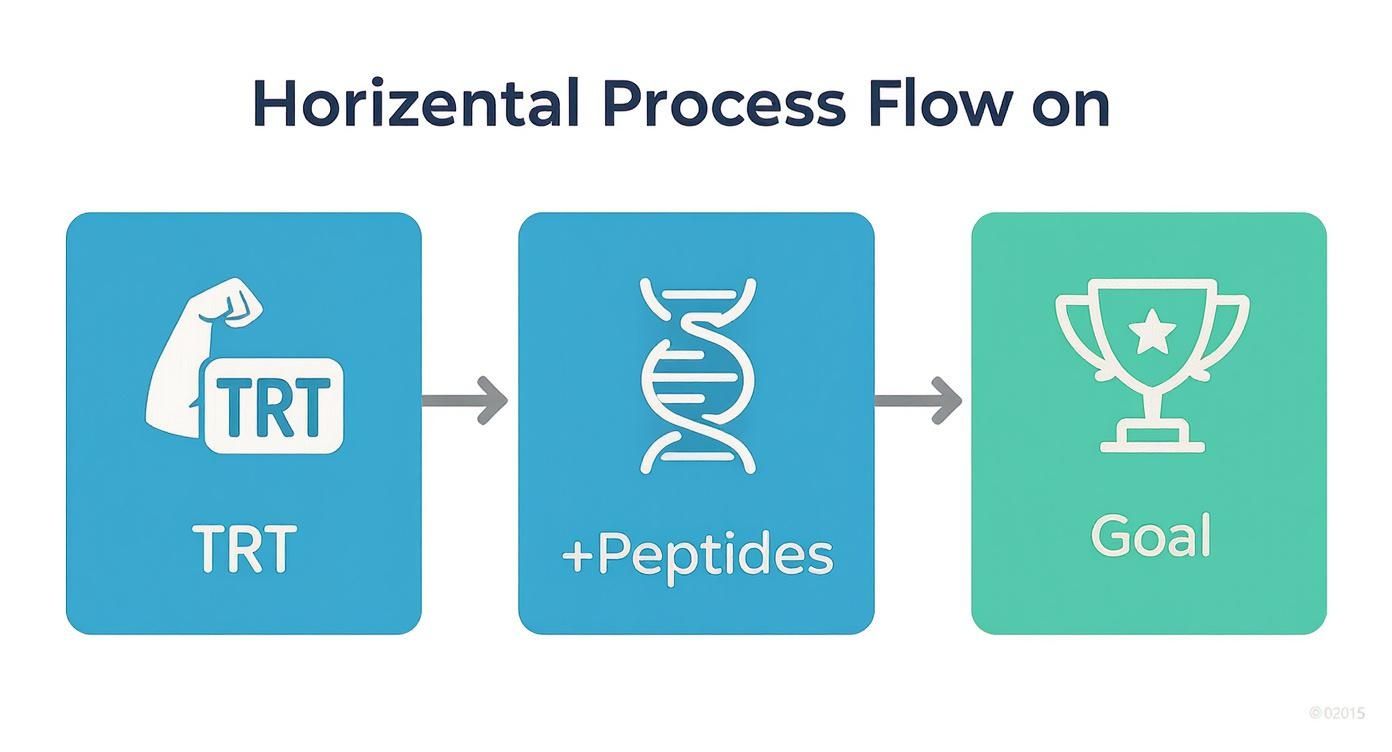
As you can see, TRT builds the strong foundation first. Then, peptides can come in and execute their specialized jobs for a much better outcome.
Managing Potential Side Effects
While incredibly effective, both TRT and peptides are powerful medical treatments. They can absolutely have side effects if they aren't managed correctly. A skilled physician sees these risks coming and uses your bloodwork to head them off, keeping your body in a state of healthy balance.
For TRT, potential side effects might include elevated estrogen levels, which can cause things like water retention or moodiness, or an increase in red blood cell count. Peptides are generally very well-tolerated, but depending on the specific one, they can sometimes cause temporary issues like water retention, fatigue, or increased hunger.
A professional medical team doesn't just react to side effects—they prevent them. By carefully monitoring your biomarkers and adjusting dosages, a physician can keep you within the optimal therapeutic window, maximizing benefits while keeping risks exceptionally low.
The Critical Importance of Sourcing
This might be the single most important safety rule of all: where you get your medications matters. The gap between a licensed U.S. pharmacy and some unregulated website is the difference between a safe, effective therapy and a dangerous gamble with your health.
-
Licensed U.S. Pharmacies: These facilities are strictly regulated by the FDA. They have to go through rigorous testing to verify the purity, potency, and sterility of every product they make. When your clinic uses these pharmacies, you know you’re getting exactly what the doctor ordered.
-
Unregulated "Research" Websites: These online sellers operate in a legal gray area, often peddling products that are not meant for people to use. There is zero oversight of how they make their stuff. Studies have repeatedly shown that products from these sites are often under-dosed, contaminated with who-knows-what, or contain a completely different substance than what's on the label.
Choosing a medical provider like Elite Bioscience guarantees your therapies are sourced only from licensed, regulated pharmacies. This commitment to quality and safety is the bedrock of any responsible hormone optimization program, giving you the confidence and peace of mind to focus on your goals.
Where Is Hormone Optimization Headed Next?
The world of hormone optimization is moving at a blistering pace. What was once an anti-aging secret whispered about in exclusive clinics is quickly becoming a respected part of proactive, preventative medicine. The days of hormone therapy being some mysterious, hard-to-access treatment are fading fast, and a few key trends are pushing the entire field forward.
Leading the charge is the explosion of telehealth. Digital platforms have torn down the old barriers, making advanced treatments like TRT and peptide therapy more accessible and convenient than ever before. This isn't just about getting treatment from your couch; it's about opening the door to personalized health protocols that were once out of reach for most people.
The New Era of Access and Telehealth
Telehealth is completely changing the game—both for who seeks treatment and how they get it. We're seeing a huge jump in prescriptions for men under 55, a trend directly fueled by the privacy and ease of telehealth, which has helped erase a lot of the old stigmas. This parallel growth in both TRT and peptide therapy is creating a more informed and empowered generation of patients. Plus, with major developments in testosterone therapies for women on the horizon, the market is poised for another massive expansion. You can get a deeper look into this evolution by exploring the future trends in telehealth hormone therapy.
This new model brings several game-changing benefits:
- Discreet Consultations: Patients can discuss sensitive health issues from the comfort and privacy of their own homes.
- A Simplified Path: From the initial blood draw to getting medications delivered right to your door, the entire process is incredibly straightforward.
- Smarter Personalization: Data-driven telehealth platforms allow for much closer monitoring and fine-tuning of your protocol, ensuring it’s always optimized for you.
What's on the Scientific Horizon?
Beyond just making it easier to get, the science itself is advancing rapidly. Researchers are constantly discovering new peptides with even more specific and powerful effects, opening the door for treatments that could target everything from cognitive decline to autoimmune disorders.
The future here is all about hyper-personalization. We are heading toward an era where your protocol isn't just based on your symptoms but is dynamically adjusted using real-time biomarker data, your genetics, and even lifestyle feedback.
Another exciting frontier is the development of new delivery systems. While injections are the standard for many therapies right now, ongoing research into oral peptides, transdermal patches, and even long-lasting implantable devices could soon make protocols even more effortless. This fusion of scientific discovery and mainstream acceptance is setting the stage for a future where optimizing your hormones is just a standard part of maintaining lifelong health and vitality.
Your Questions Answered: Expert Insights on TRT and Peptides
As we wrap things up, let's tackle some of the most common questions that come up when people start looking into the powerful combination of TRT and peptides. This is a significant investment in your health, so it's completely normal to have practical questions about getting started, what to expect, and how to make the right call.
Our goal here is to give you clear, straight-to-the-point answers, clearing up any final uncertainties so you can move forward with confidence.
Can I Use Peptides Without Being on TRT?
Absolutely. Peptides can be incredibly effective on their own for specific goals. Think of using BPC-157 for an injury or Ipamorelin to get better sleep. They work.
However, it helps to think of your body’s hormonal system like a high-performance engine. If low testosterone is like running with low oil, peptides are like specialized, high-octane fuel. The fuel will work, but the engine is going to run far more powerfully and efficiently once its fundamental systems are optimized first.
For anyone with clinically low testosterone, combining TRT and peptides creates a powerful synergy. TRT sets the stage—it creates the ideal physiological environment for peptides to deliver their maximum, targeted results.
How Long Does It Take to See Results?
This will always vary from person to person based on their unique physiology and protocol, but we can talk in general timelines.
- With TRT, you'll often feel improvements in mood, energy, and libido within the first 3-6 weeks.
- Physical changes, like more muscle and noticeable fat loss, usually become more apparent after 3-6 months of consistent therapy.
Peptides often work on a faster, more function-specific timeline. A growth hormone secretagogue might improve your sleep quality within just a few days, while a healing peptide could significantly reduce pain from an injury in a matter of weeks. The real key to getting and keeping long-term benefits is consistency with your prescribed protocol.
Your timeline is your own. Patience and consistency are your greatest allies here. While some benefits show up quickly, the most significant changes unfold over several months of dedicated treatment.
What Are the Primary Costs Involved?
The cost of these therapies can vary quite a bit depending on your clinic, location, and the exact medications in your protocol.
Generally, you can expect the main expenses to fall into these categories:
- Initial Consultation & Lab Work: This can run anywhere from $200 to $500+.
- Medications: TRT on its own is typically $100-$300 per month. Adding peptides can increase this by another $150-$500+ per month, depending on the type and dose.
- Follow-Up Appointments: These are essential for monitoring your progress and making adjustments.
While insurance might cover TRT for a clinical diagnosis of hypogonadism, it almost never covers peptide therapies, as they're often considered elective wellness treatments. It's crucial to have a frank conversation about the full financial commitment with your provider upfront so there are no surprises down the road.
Ready to explore how a personalized hormone optimization plan can help you reach your peak potential? At Elite Bioscience, we provide medically supervised TRT and peptide therapies sourced from licensed U.S. pharmacies, delivered directly and discreetly to your door.
Start your confidential health assessment today at https://elitebioscience.co
QUICK SEARCH
Make an account today to start your journey towards a better and healthier lifestyle.
